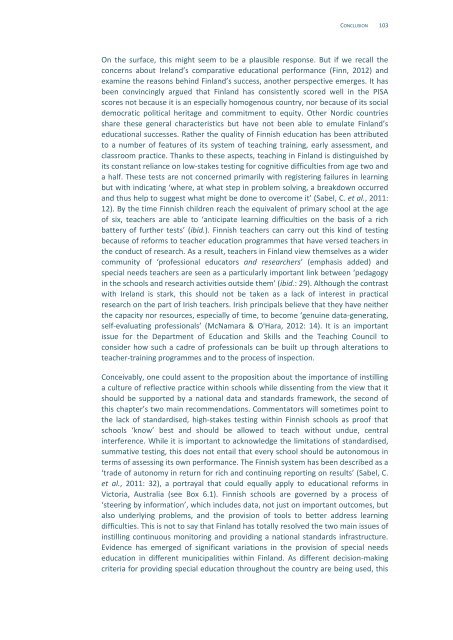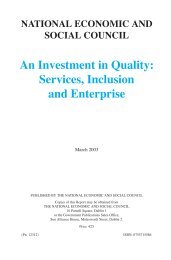Quality and Standards in Human Services in Ireland - the NESC ...
Quality and Standards in Human Services in Ireland - the NESC ...
Quality and Standards in Human Services in Ireland - the NESC ...
Create successful ePaper yourself
Turn your PDF publications into a flip-book with our unique Google optimized e-Paper software.
CONCLUSION 103On <strong>the</strong> surface, this might seem to be a plausible response. But if we recall <strong>the</strong>concerns about Irel<strong>and</strong>’s comparative educational performance (F<strong>in</strong>n, 2012) <strong>and</strong>exam<strong>in</strong>e <strong>the</strong> reasons beh<strong>in</strong>d F<strong>in</strong>l<strong>and</strong>’s success, ano<strong>the</strong>r perspective emerges. It hasbeen conv<strong>in</strong>c<strong>in</strong>gly argued that F<strong>in</strong>l<strong>and</strong> has consistently scored well <strong>in</strong> <strong>the</strong> PISAscores not because it is an especially homogenous country, nor because of its socialdemocratic political heritage <strong>and</strong> commitment to equity. O<strong>the</strong>r Nordic countriesshare <strong>the</strong>se general characteristics but have not been able to emulate F<strong>in</strong>l<strong>and</strong>’seducational successes. Ra<strong>the</strong>r <strong>the</strong> quality of F<strong>in</strong>nish education has been attributedto a number of features of its system of teach<strong>in</strong>g tra<strong>in</strong><strong>in</strong>g, early assessment, <strong>and</strong>classroom practice. Thanks to <strong>the</strong>se aspects, teach<strong>in</strong>g <strong>in</strong> F<strong>in</strong>l<strong>and</strong> is dist<strong>in</strong>guished byits constant reliance on low-stakes test<strong>in</strong>g for cognitive difficulties from age two <strong>and</strong>a half. These tests are not concerned primarily with register<strong>in</strong>g failures <strong>in</strong> learn<strong>in</strong>gbut with <strong>in</strong>dicat<strong>in</strong>g ‘where, at what step <strong>in</strong> problem solv<strong>in</strong>g, a breakdown occurred<strong>and</strong> thus help to suggest what might be done to overcome it’ (Sabel, C. et al., 2011:12). By <strong>the</strong> time F<strong>in</strong>nish children reach <strong>the</strong> equivalent of primary school at <strong>the</strong> ageof six, teachers are able to ‘anticipate learn<strong>in</strong>g difficulties on <strong>the</strong> basis of a richbattery of fur<strong>the</strong>r tests’ (ibid.). F<strong>in</strong>nish teachers can carry out this k<strong>in</strong>d of test<strong>in</strong>gbecause of reforms to teacher education programmes that have versed teachers <strong>in</strong><strong>the</strong> conduct of research. As a result, teachers <strong>in</strong> F<strong>in</strong>l<strong>and</strong> view <strong>the</strong>mselves as a widercommunity of ‘professional educators <strong>and</strong> researchers’ (emphasis added) <strong>and</strong>special needs teachers are seen as a particularly important l<strong>in</strong>k between ‘pedagogy<strong>in</strong> <strong>the</strong> schools <strong>and</strong> research activities outside <strong>the</strong>m’ (ibid.: 29). Although <strong>the</strong> contrastwith Irel<strong>and</strong> is stark, this should not be taken as a lack of <strong>in</strong>terest <strong>in</strong> practicalresearch on <strong>the</strong> part of Irish teachers. Irish pr<strong>in</strong>cipals believe that <strong>the</strong>y have nei<strong>the</strong>r<strong>the</strong> capacity nor resources, especially of time, to become ‘genu<strong>in</strong>e data-generat<strong>in</strong>g,self-evaluat<strong>in</strong>g professionals’ (McNamara & O'Hara, 2012: 14). It is an importantissue for <strong>the</strong> Department of Education <strong>and</strong> Skills <strong>and</strong> <strong>the</strong> Teach<strong>in</strong>g Council toconsider how such a cadre of professionals can be built up through alterations toteacher-tra<strong>in</strong><strong>in</strong>g programmes <strong>and</strong> to <strong>the</strong> process of <strong>in</strong>spection.Conceivably, one could assent to <strong>the</strong> proposition about <strong>the</strong> importance of <strong>in</strong>still<strong>in</strong>ga culture of reflective practice with<strong>in</strong> schools while dissent<strong>in</strong>g from <strong>the</strong> view that itshould be supported by a national data <strong>and</strong> st<strong>and</strong>ards framework, <strong>the</strong> second ofthis chapter’s two ma<strong>in</strong> recommendations. Commentators will sometimes po<strong>in</strong>t to<strong>the</strong> lack of st<strong>and</strong>ardised, high-stakes test<strong>in</strong>g with<strong>in</strong> F<strong>in</strong>nish schools as proof thatschools ‘know’ best <strong>and</strong> should be allowed to teach without undue, central<strong>in</strong>terference. While it is important to acknowledge <strong>the</strong> limitations of st<strong>and</strong>ardised,summative test<strong>in</strong>g, this does not entail that every school should be autonomous <strong>in</strong>terms of assess<strong>in</strong>g its own performance. The F<strong>in</strong>nish system has been described as a‘trade of autonomy <strong>in</strong> return for rich <strong>and</strong> cont<strong>in</strong>u<strong>in</strong>g report<strong>in</strong>g on results’ (Sabel, C.et al., 2011: 32), a portrayal that could equally apply to educational reforms <strong>in</strong>Victoria, Australia (see Box 6.1). F<strong>in</strong>nish schools are governed by a process of‘steer<strong>in</strong>g by <strong>in</strong>formation’, which <strong>in</strong>cludes data, not just on important outcomes, butalso underly<strong>in</strong>g problems, <strong>and</strong> <strong>the</strong> provision of tools to better address learn<strong>in</strong>gdifficulties. This is not to say that F<strong>in</strong>l<strong>and</strong> has totally resolved <strong>the</strong> two ma<strong>in</strong> issues of<strong>in</strong>still<strong>in</strong>g cont<strong>in</strong>uous monitor<strong>in</strong>g <strong>and</strong> provid<strong>in</strong>g a national st<strong>and</strong>ards <strong>in</strong>frastructure.Evidence has emerged of significant variations <strong>in</strong> <strong>the</strong> provision of special needseducation <strong>in</strong> different municipalities with<strong>in</strong> F<strong>in</strong>l<strong>and</strong>. As different decision-mak<strong>in</strong>gcriteria for provid<strong>in</strong>g special education throughout <strong>the</strong> country are be<strong>in</strong>g used, this
















